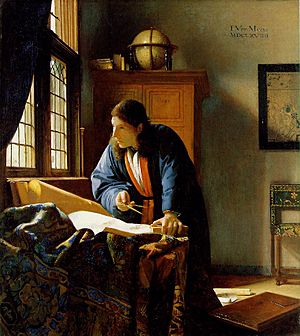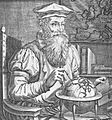Geographer facts for kids

A geographer is a scientist who studies geography. Geography is all about understanding our Earth. It looks at both the natural world around us and how humans live in it.
Long ago, geographers were mostly known for making maps. Today, map-making is a special skill called cartography. It's a part of geography, but geographers do much more! They don't just study the physical details of the Earth. They also look at how the environment affects everything. This includes how humans and wildlife live together (their ecologies). They also study weather and climate patterns, economics, and culture. Geographers focus on how space influences the connections between all these different things.
Contents
What is Geography?
Geography is a big field of study. It helps us understand our planet better. It explores where things are, why they are there, and how they change over time. Geographers ask questions like:
- Why do some places have deserts and others have forests?
- How do people use the land around them?
- What causes different weather patterns?
- How do people and their environment interact?
By answering these questions, geographers help us solve real-world problems. They can help with planning cities, managing natural resources, and understanding climate change.
The Earth's Physical Environment
One main part of geography is studying the Earth's physical features. This includes:
- Landforms: Like mountains, valleys, plains, and coastlines.
- Water bodies: Such as oceans, rivers, lakes, and glaciers.
- Climate: The long-term weather patterns of a region.
- Soils: The different types of ground that plants grow in.
- Plants and Animals: Where different types of life are found.
Geographers look at how these features were formed. They also study how they change over time, both naturally and because of human actions.
Humans and Their Environment
Geographers also study how humans live on Earth. They look at how people use the land. They also study how human activities affect the environment. This part of geography includes:
- Population: Where people live and why.
- Cities and Towns: How they grow and are organized.
- Culture: How different groups of people live and interact.
- Economics: How people make and use resources.
- Movement: How people, goods, and ideas travel across the Earth.
Understanding these connections helps us build better communities. It also helps us protect our planet for the future.
Key Ideas in Geography
The National Geographic Society has identified five main themes that geographers use to understand the world. These themes help us think like a geographer:
- Location: This answers the question, "Where is it?" It can be an exact spot (like coordinates) or a general area (like "near the school").
- Place: This describes what a location is like. What are its physical features? What are the human characteristics, like culture or buildings?
- Human-Environment Interaction: This looks at how people change the environment and how the environment changes people. For example, building a dam changes a river, and a hot climate affects how people dress.
- Movement: This theme explores how people, goods, and ideas travel from one place to another. Think about how products get to your store or how news spreads.
- Regions: This groups areas together that share common features. A region could be defined by its climate, its language, or its type of government.
Images for kids
-
Gerardus Mercator was a famous mapmaker.
See also
 In Spanish: Geógrafo para niños
In Spanish: Geógrafo para niños


